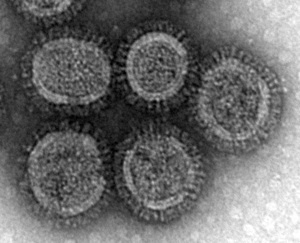H5N1 bird flu genes show nature can pick worrisome traits
In the beginning, all flu viruses came from birds.
Over time, the virus evolved to adapt to other animals, including humans, as natural selection favored viruses with mutations that allowed them to more readily infect the cells of new host species. For some strains of bird flu virus, notably the worrisome H5N1 variant, the genetic changes that could make human-to-human transmission a possibility and spark a pandemic are the markers of intense interest to those who track flu as a threat to human health.

A deep look into the genes of transmitted H5N1 viruses reveals the surprising degree to which the virus can mutate and genetically diversify in each infected host — a troubling trait for a pathogen that has so far infected 637 people, killing 378.
Photo: Takeshi Noda, University of Tokyo
Now, in a study published today (Oct. 23, 2013) in Nature Communications, an international team of researchers shows how evolution can favor mutations that make avian flu more transmissible in mammals.
The study used what scientists call “deep sequencing” to identify low-frequency genetic mutations that occur as the virus grows in and transmits between animals. Combing the genetic data from a transmission study in ferrets, a team led by Thomas Friedrich, a professor of pathobiological sciences at the UW–Madison School of Veterinary Medicine, found that during transmission, when one animal is infected by another through sneezing or coughing, the process of natural selection acts strongly on hemagglutinin, the structure the virus uses to attach to and infect host cells.
The deep look into the genes of transmitted H5N1 viruses also reveals the surprising degree to which the virus can mutate and genetically diversify in each infected host, a troubling trait for a pathogen that has so far infected 637 people, killing 378. The team’s data emphasize the fact that influenza viruses exist in each infected individual — bird, human or ferret — as a population or “swarm” of genetically related, but distinct, mutants.
A mutation occurs somewhere on the viral genome every time a virus infects a cell, Friedrich explains. “You might think they all have the same sequence, but they don’t. We found that this diversity increases over time in essentially all infected individuals we examined.”

Thomas Friedrich
Perhaps their most surprising and troubling discovery was that mutations present in only about 6 percent of the viruses infecting one ferret could be transmitted to another. This suggests that even very rare mutants can be transmitted if they have an evolutionary advantage.
Most human infections with H5N1 viruses come directly from birds and are not transmitted to other people. Past studies have identified four key genetic mutations needed for the virus to become transmissible between mammals. Surveillance by public health officials has already identified viruses containing one or more of the required mutations from fowl in Egypt and some Asian countries.
The data, Friedrich says, indicate that viruses capable of infecting humans probably already exist in nature, but at very low frequencies. Those findings, he adds, suggest that current surveillance methods may be missing H5N1 viruses capable of making the leap from birds to humans.
“Traditional sequencing can detect a mutation if it’s present in maybe 20 percent or 30 percent of viruses. We were able to detect the transmission of rare mutants in this study only because we used deep sequencing. So there may be a background of transmissible viruses we are missing because surveillance currently relies on older technologies,” says Friedrich. “Maybe they’ve always been there and we just couldn’t see them. There may be viruses out there just one or zero mutations away. They just haven’t encountered a susceptible host.”
“If natural selection is playing a role, it will favor transmission of that one-in-a-million virus.”
Thomas Friedrich
The new work drew on transmission studies conducted last year in the lab of Yoshihiro Kawaoka, a co-author of the new study and also a professor of pathobiological sciences at the UW–Madison School of Veterinary Medicine. The original studies examined the transmission of an engineered variant of the H5N1 virus between ferrets. Friedrich and his colleagues analyzed the genes of these variant viruses in their new study; no new ferret experiments were performed for the new analysis.
“Fully avian viruses may act differently in nature,” he notes. “But the data suggest to us that it wouldn’t take many viruses from a chicken to infect a person, if the right mutations were there — even if they were a tiny minority of the overall virus population. I suspect that result will hold true.”
A key aim of the study was to determine how transmission from one host to another affects the virus’s genetic makeup. Researchers believed that transmission would reduce the genetic diversity present in the virus, but it was unclear whether genetic changes associated with transmission were random or if natural selection might favor mutations to make it more transmissible. “We found evidence for natural selection occurring. We see it playing a role in which viruses start an infection, creating a genetic bottleneck,” Friedrich says.
A genetic bottleneck occurs when the survival of an organism with certain traits or mutations is favored over others in the same population, reducing the overall genetic diversity in subsequent generations. “If natural selection is playing a role, it will favor transmission of that one-in-a-million virus,” Friedrich notes.
Tags: animal research, biosciences, influenza, research



